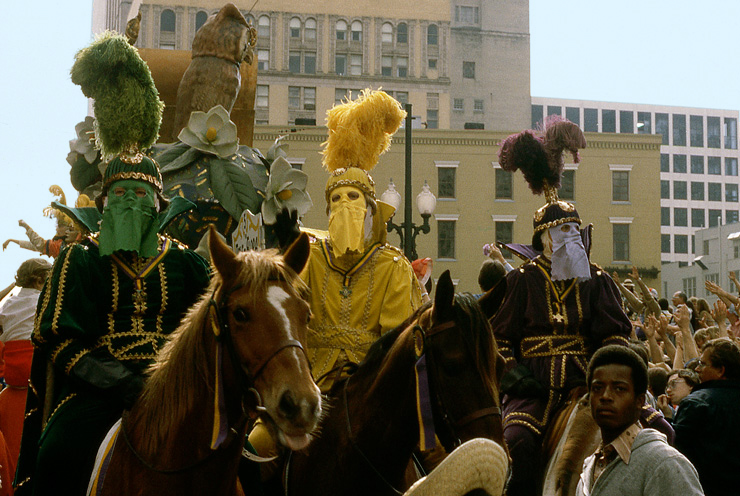
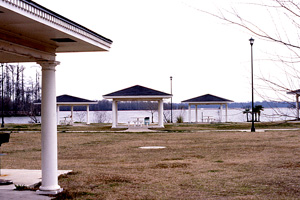
Rest stop on the Texas/Louisiana border
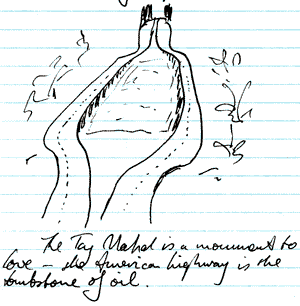
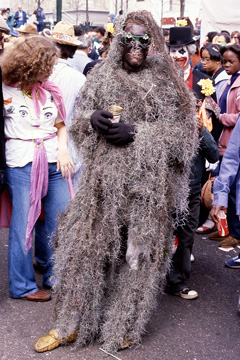
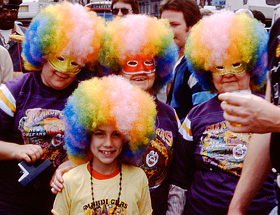
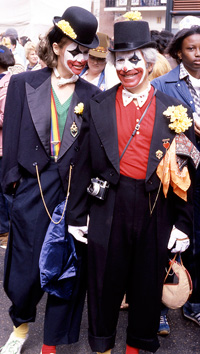
We drove 400 miles from Houston, Texas, to New Orleans in Louisiana for Mardi Gras. We soon noticed several dogs dead by the roadside, hit by the fast-moving traffic. There were more than a dozen. Apparently no one ever bothers to dispose of the bodies and some of them were quite bloated. It was not a pretty sight, particularly if you have any feeling for dogs.
The Texas countryside was flat and stretched for miles on either side. Every town was spaciously laid out, with large areas around the houses and shops, and set well back from the road. But it changed dramatically once we got into Louisiana.
Here the bayou swamps began. Large tracts of brown bedraggled trees knee-deep in mud and water stretched out on both sides of the highway. In places they were thick, then they thinned out into islands with limp twisted ribbons of black water between them. There was even a decrepit wooden house stuck in the middle of a clump of bony brown trees. It sat drunkenly just above the fetid water which was the only apparent access. One house had a long punt-like rowing boat drawn up beside it.
The highway itself was like an extended bridge - or rather a pair of bridges, two lanes going one way, two lanes the other about a hundred feet away, both sitting on round concrete piles supporting the concrete highway 20 feet above the muddy waters. This went on for at least 15 miles. The roads came together and rose up in a graceful arch a couple of times when they became real bridges crossing rivers, spanning a wider, moving version of the otherwise stagnant water.
The top of the arch gave a vista that was like a vicious caricature of the Taj Mahal in India. There the palace is a work of art, a highly decorated, lavishly ornate and luxurious edifice floating at the end of a bright blue pure waterway. Here perspective brought the two roadways together to embrace the brackish swamp water with its gnarled stunted trees, while in the distance the twin towers of the next bridge rose above the exhaust fumes. The Taj Mahal was built by a love-sick rajah, but in America the car is king and the perfect straight highways forever swarming with vehicles are the horizontal tombstones of billion-dollar oil profits.
When we arrived at New Orleans just before dusk we went to Fat City where a procession was due to start. Fat City could be any city in urban America - an endless series of gas stations, billboard signs, one- or two-story offices and shopping centers, mobile homes and Recreational Vehicles in used-car lots, acre after acre after acre, serviced by the long concrete strips packed with moving impatient chrome-plated juggernauts.
So we moved on to find the French Quarter, the "real" New Orleans. It sits next to the business center with sky-scrapers shouldering the freeways aside. But once you enter the narrow streets of the historic French Quarter a different feeling emerges. It becomes a community. Nothing is organized. There is no pressure to be anywhere and individuality is allowed to flower.
The streets were filled with people celebrating Mardi Gras. Most places had signs, ominously enough, saying "No Public Restrooms" or "Restrooms for Paying Customers Only". When we felt the pinch we searched for about half an hour, then finally resorted to the subterfuge of going into a restaurant, waiting at a table, trickling off to use the restroom in ones and twos, then leaving before we ordered.
Later the queues to enter the restaurants became so long that even that wasn't a very good solution. I don't know what the thousands of Mardi Gras revelers, many of them obviously drinking heavily, did. Judging from the state of the streets some of them had lost the distinction between public and private.
Even many of the bars were not making their facilities readily available. Most of them had erected barriers to repel the invasion, disguised as temporary bars, that shut off most of the room and transformed them into take-away drink dispensers. The rest had entertainment and a heavy cover charge and high-priced drinks. One little bar we went into on Bourbon Street had a great little rhythm and blues band with more sophistication than that category usually implies. The bar charged only a dollar to get in but a double whisky cost $2.50. The band was worth the dollar and the price of the drink. It had an accomplished and facile lead guitarist, an energetic pianist on the original honky-tonk piano, and a bass guitarist and drummer who worked together like a heartbeat and its pulse.
We found an organized little Italian-style restaurant down near the French Market which had a doorman to stop it becoming too crowded. It served excellent "Po' Boys", the local sandwich with lovely French bread you had to tear at with your teeth. The waiter gave us a bottle of Siglio red wine, telling us we could finish it. Unfortunately Praline (who received her name as soon as we saw this local biscuit advertised) developed a migraine, but it was time we found a bed for the night anyway. We drove up Airline Boulevard rejecting $45 rooms ... $35 ... $30 ... and finally accepted a $25 room a few miles from the French Quarter.
What we saved in money we paid for in lack of sleep. We discovered Airline Boulevard was not only on the flight path of the airport, but had a railway line running down one side of it as well. All the trains sounded their whistles - three long blasts - before every railway crossing. Which was every block.
The Texas countryside was flat and stretched for miles on either side. Every town was spaciously laid out, with large areas around the houses and shops, and set well back from the road. But it changed dramatically once we got into Louisiana.
Here the bayou swamps began. Large tracts of brown bedraggled trees knee-deep in mud and water stretched out on both sides of the highway. In places they were thick, then they thinned out into islands with limp twisted ribbons of black water between them. There was even a decrepit wooden house stuck in the middle of a clump of bony brown trees. It sat drunkenly just above the fetid water which was the only apparent access. One house had a long punt-like rowing boat drawn up beside it.
The highway itself was like an extended bridge - or rather a pair of bridges, two lanes going one way, two lanes the other about a hundred feet away, both sitting on round concrete piles supporting the concrete highway 20 feet above the muddy waters. This went on for at least 15 miles. The roads came together and rose up in a graceful arch a couple of times when they became real bridges crossing rivers, spanning a wider, moving version of the otherwise stagnant water.
The top of the arch gave a vista that was like a vicious caricature of the Taj Mahal in India. There the palace is a work of art, a highly decorated, lavishly ornate and luxurious edifice floating at the end of a bright blue pure waterway. Here perspective brought the two roadways together to embrace the brackish swamp water with its gnarled stunted trees, while in the distance the twin towers of the next bridge rose above the exhaust fumes. The Taj Mahal was built by a love-sick rajah, but in America the car is king and the perfect straight highways forever swarming with vehicles are the horizontal tombstones of billion-dollar oil profits.
When we arrived at New Orleans just before dusk we went to Fat City where a procession was due to start. Fat City could be any city in urban America - an endless series of gas stations, billboard signs, one- or two-story offices and shopping centers, mobile homes and Recreational Vehicles in used-car lots, acre after acre after acre, serviced by the long concrete strips packed with moving impatient chrome-plated juggernauts.
So we moved on to find the French Quarter, the "real" New Orleans. It sits next to the business center with sky-scrapers shouldering the freeways aside. But once you enter the narrow streets of the historic French Quarter a different feeling emerges. It becomes a community. Nothing is organized. There is no pressure to be anywhere and individuality is allowed to flower.
The streets were filled with people celebrating Mardi Gras. Most places had signs, ominously enough, saying "No Public Restrooms" or "Restrooms for Paying Customers Only". When we felt the pinch we searched for about half an hour, then finally resorted to the subterfuge of going into a restaurant, waiting at a table, trickling off to use the restroom in ones and twos, then leaving before we ordered.
Later the queues to enter the restaurants became so long that even that wasn't a very good solution. I don't know what the thousands of Mardi Gras revelers, many of them obviously drinking heavily, did. Judging from the state of the streets some of them had lost the distinction between public and private.
Even many of the bars were not making their facilities readily available. Most of them had erected barriers to repel the invasion, disguised as temporary bars, that shut off most of the room and transformed them into take-away drink dispensers. The rest had entertainment and a heavy cover charge and high-priced drinks. One little bar we went into on Bourbon Street had a great little rhythm and blues band with more sophistication than that category usually implies. The bar charged only a dollar to get in but a double whisky cost $2.50. The band was worth the dollar and the price of the drink. It had an accomplished and facile lead guitarist, an energetic pianist on the original honky-tonk piano, and a bass guitarist and drummer who worked together like a heartbeat and its pulse.
We found an organized little Italian-style restaurant down near the French Market which had a doorman to stop it becoming too crowded. It served excellent "Po' Boys", the local sandwich with lovely French bread you had to tear at with your teeth. The waiter gave us a bottle of Siglio red wine, telling us we could finish it. Unfortunately Praline (who received her name as soon as we saw this local biscuit advertised) developed a migraine, but it was time we found a bed for the night anyway. We drove up Airline Boulevard rejecting $45 rooms ... $35 ... $30 ... and finally accepted a $25 room a few miles from the French Quarter.
What we saved in money we paid for in lack of sleep. We discovered Airline Boulevard was not only on the flight path of the airport, but had a railway line running down one side of it as well. All the trains sounded their whistles - three long blasts - before every railway crossing. Which was every block.
* * * * *
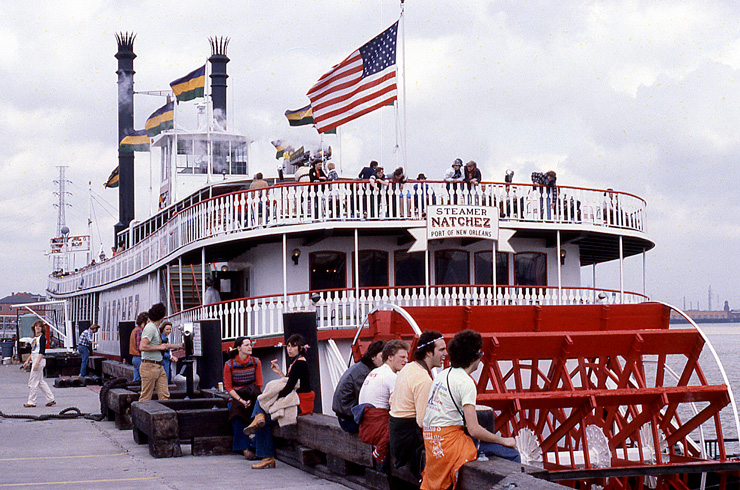
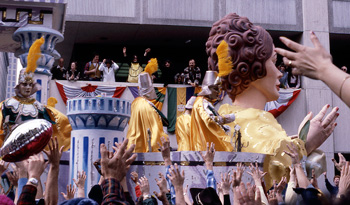
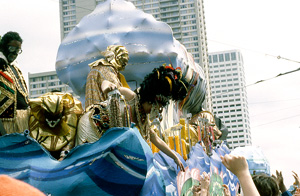
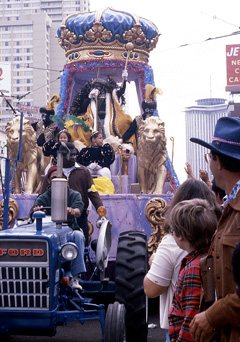
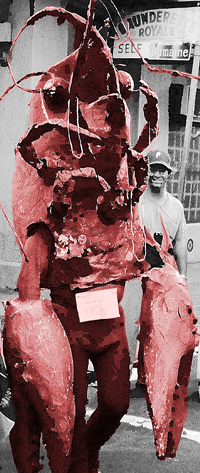
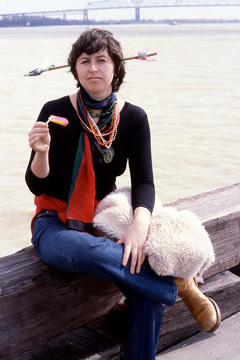
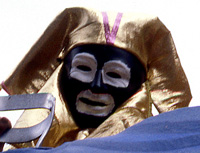
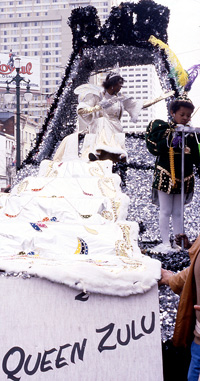
Mardi Gras means literally "Fat Tuesday", the day before Ash Wednesday and the start of Lent, the last chance to indulge in all the appetites before the rigors of fasting begin.
The most famous processions of all majestically tour New Orleans streets on this day. They climax two full weeks of parades both in the city and in the suburbs. The processions are devised and organized by "Krewes". The day of Mardi Gras is reserved for the Krewes of Zulu, Rex, and early in the evening, Comus. The day is capped by a grand - and exclusive - ball put on by the combined Krewes of Rex and Comus.
Canal Street, touted by the locals as the "widest main street in the world", is the best vantage point, for the parades go up one side then down the other. The huge floats are preceded by horse riders dressed in flamboyant costumes, motorcycle police, marching bands, marching girls (all strutting disco style) and best of all the informal street bands jamming in the original dixieland jazz.
The floats were one to two stories high and were pulled by tractors. The designs were fantastic and elaborate. The most care had been lavished on the costumes worn by the people on the floats ... gorgeous costumes in many colors, covered with decorations of embroidery and intricate designs.
Audience participation is assured by an old and time-honored custom of throwing presents into the street. The most common are gaudy plastic many-colored necklaces that are flung into the sea of upstretched hands, everyone seeking, shouting, pleading, pushing for a prize. Each float had cartons of necklaces to dispense.
The necklaces were made up of a dazzling variety of different shapes, designs and colors, most of them individually strung. Together, if you collected and wore half a dozen or more, they made up a brilliant display of color and variety that was quite impressive.
Next up in value or rarity were the necklaces with plastic medals on them with the insignia of the particular Krewe giving the throw - Zulu or Rex, etc. The most popular collectors' item was the doubloon - an aluminum coin the size of a crown with the crest or sign of the Krewe and the date of its founding on one side, and the theme of the procession and the current year on the other.
Finally there was the grand, and rare, prize of a "coconut" wrapped in gold tinsel paper. Apparently in the early days this used to be a real coconut, but that proved to be too dangerous an object to throw into the crowd. Today it is made of the much less exotic but far safer material of plastic.
The flamboyant costumes of the floats were often rivaled by the ordinary onlookers on the streets. Many of the spectators dressed themselves up in full costume down to the last detail. King Henry the Eighth was holding court with at least 20 of his nobles and their ladies ... a fully rigged Viking complete with axes was there ... and so on down to quite playful of make-believe costumes. One person was dressed entirely in flowing gold robes complete with gold mask. Another was in silver but instead of a mask he had completely silvered his bald wrinkled head and face. He may even have shaved his head just for the occasion. Others had the bottom cut out of their costumes, displaying their bare buttocks to the world, two wore nothing but jock straps, and others were even ruder. My favorite was a gentleman who represented the lobster, or crayfish, complete with claws for hands and long repulsive feelers.
That night the grand march of Comus and Rex at the Ball revealed the high society pretensions underpinning the festivities. The genealogy of each participant was given in hushed tones by the commentator, even including the little Lord Fauntleroys who held the train of each golden girl. Most of them had hyphenated names, or had that proud ancestral suffix of "Junior", or "The Third". And all of them were incestuously local in their lineage.
One lady nearly didn't make it - she came from two states away, Alabama. But the commentator hastily added that she went to university in Louisiana and now worked in New Orleans. She just scraped in on the verge of non-acceptance by the sound of it.
The bewigged and begowned figures of Comus and Rex themselves were at the top of the social tree. One was a banker, a member of the local Presbyterian elders, belonged to this committee and that board of directors, and probably had the local senator and Congressman on his payroll as well.
It became obvious that Mardi Gras was the time when all of New Orleans high society received its homage and rewards. Nobody could say it was important but the ritual was decidedly pompous and oh so serious. The grand parade was undertaken with the solemnity usually granted to coronations of kings. The ceremony was of course highly significant to the participants ... it spelt out the pecking order of the local dignatories.
In the end it is the isolated cameos of Mardi Gras that linger in the memory:
The most famous processions of all majestically tour New Orleans streets on this day. They climax two full weeks of parades both in the city and in the suburbs. The processions are devised and organized by "Krewes". The day of Mardi Gras is reserved for the Krewes of Zulu, Rex, and early in the evening, Comus. The day is capped by a grand - and exclusive - ball put on by the combined Krewes of Rex and Comus.
Canal Street, touted by the locals as the "widest main street in the world", is the best vantage point, for the parades go up one side then down the other. The huge floats are preceded by horse riders dressed in flamboyant costumes, motorcycle police, marching bands, marching girls (all strutting disco style) and best of all the informal street bands jamming in the original dixieland jazz.
The floats were one to two stories high and were pulled by tractors. The designs were fantastic and elaborate. The most care had been lavished on the costumes worn by the people on the floats ... gorgeous costumes in many colors, covered with decorations of embroidery and intricate designs.
Audience participation is assured by an old and time-honored custom of throwing presents into the street. The most common are gaudy plastic many-colored necklaces that are flung into the sea of upstretched hands, everyone seeking, shouting, pleading, pushing for a prize. Each float had cartons of necklaces to dispense.
The necklaces were made up of a dazzling variety of different shapes, designs and colors, most of them individually strung. Together, if you collected and wore half a dozen or more, they made up a brilliant display of color and variety that was quite impressive.
Next up in value or rarity were the necklaces with plastic medals on them with the insignia of the particular Krewe giving the throw - Zulu or Rex, etc. The most popular collectors' item was the doubloon - an aluminum coin the size of a crown with the crest or sign of the Krewe and the date of its founding on one side, and the theme of the procession and the current year on the other.
Finally there was the grand, and rare, prize of a "coconut" wrapped in gold tinsel paper. Apparently in the early days this used to be a real coconut, but that proved to be too dangerous an object to throw into the crowd. Today it is made of the much less exotic but far safer material of plastic.
The flamboyant costumes of the floats were often rivaled by the ordinary onlookers on the streets. Many of the spectators dressed themselves up in full costume down to the last detail. King Henry the Eighth was holding court with at least 20 of his nobles and their ladies ... a fully rigged Viking complete with axes was there ... and so on down to quite playful of make-believe costumes. One person was dressed entirely in flowing gold robes complete with gold mask. Another was in silver but instead of a mask he had completely silvered his bald wrinkled head and face. He may even have shaved his head just for the occasion. Others had the bottom cut out of their costumes, displaying their bare buttocks to the world, two wore nothing but jock straps, and others were even ruder. My favorite was a gentleman who represented the lobster, or crayfish, complete with claws for hands and long repulsive feelers.
That night the grand march of Comus and Rex at the Ball revealed the high society pretensions underpinning the festivities. The genealogy of each participant was given in hushed tones by the commentator, even including the little Lord Fauntleroys who held the train of each golden girl. Most of them had hyphenated names, or had that proud ancestral suffix of "Junior", or "The Third". And all of them were incestuously local in their lineage.
One lady nearly didn't make it - she came from two states away, Alabama. But the commentator hastily added that she went to university in Louisiana and now worked in New Orleans. She just scraped in on the verge of non-acceptance by the sound of it.
The bewigged and begowned figures of Comus and Rex themselves were at the top of the social tree. One was a banker, a member of the local Presbyterian elders, belonged to this committee and that board of directors, and probably had the local senator and Congressman on his payroll as well.
It became obvious that Mardi Gras was the time when all of New Orleans high society received its homage and rewards. Nobody could say it was important but the ritual was decidedly pompous and oh so serious. The grand parade was undertaken with the solemnity usually granted to coronations of kings. The ceremony was of course highly significant to the participants ... it spelt out the pecking order of the local dignatories.
In the end it is the isolated cameos of Mardi Gras that linger in the memory:
- The attention and comments excited by Helen's and Pauline's trick arrows-through-the-head - Lady, did you know you had an arrow through your head? (Although where could the conversation go from there?)
- The group of black women up on a grandstand in the middle of Canal Street who laughed and pointed at the arrows ... then recoiled in real fright when Helen "shot" them with her paper yo-yo, a long piece of paper rolled up round a stick which could shoot out several feet like a snake striking. When the women realized the trick they shrieked with pleasure.
- Sitting in the sun on the wharf on the edge of the Mississippi behind the paddle steamer Natchez listening to the steam calliope on its promenade deck playing old American favorites.
- Eating beignets covered with powdered sugar near the French Market, next to the bald man who had silvered his entire head.
- The band on the balcony in Royal Street and all the heads poking out of the windows around it while the dixieland jazz swung along.
- The Po' Boy sandwiches of magnificent crusty sourdough French bread filled with hot German Sausage and onions and peppers and tomatoes and sauce and mustard.
- The old paunchy woman with straggly gray hair who constantly tried to stand on her head while the street band played. She bent over, put her hands on the ground, ducked her head down then thrust up with her legs. She toppled right over on her back showing long gray woolen stockings under her dowdy black dress. Then, to applause from the spectators, she struggled to her feet and tried again ... and again ... and again.
- The ordinary looking youths in T-shirts and jeans who nevertheless had something decidedly odd about their appearance ... then the realization dawned. They had rubber noses shaped like penises.
- The girls on the second story balcony flashing the signs "Show Your Tits" and "Show Your Manhood"! When I shouted with schoolboy bravado: "Show me yours and I'll show you mine!" the challenge was taken up with far too much alacrity to suit my normally shy and cautious nature, and I retired in confusion behind Helen's fur collar. Just another sensation of the night.
Ku Klux Klan, beware!
